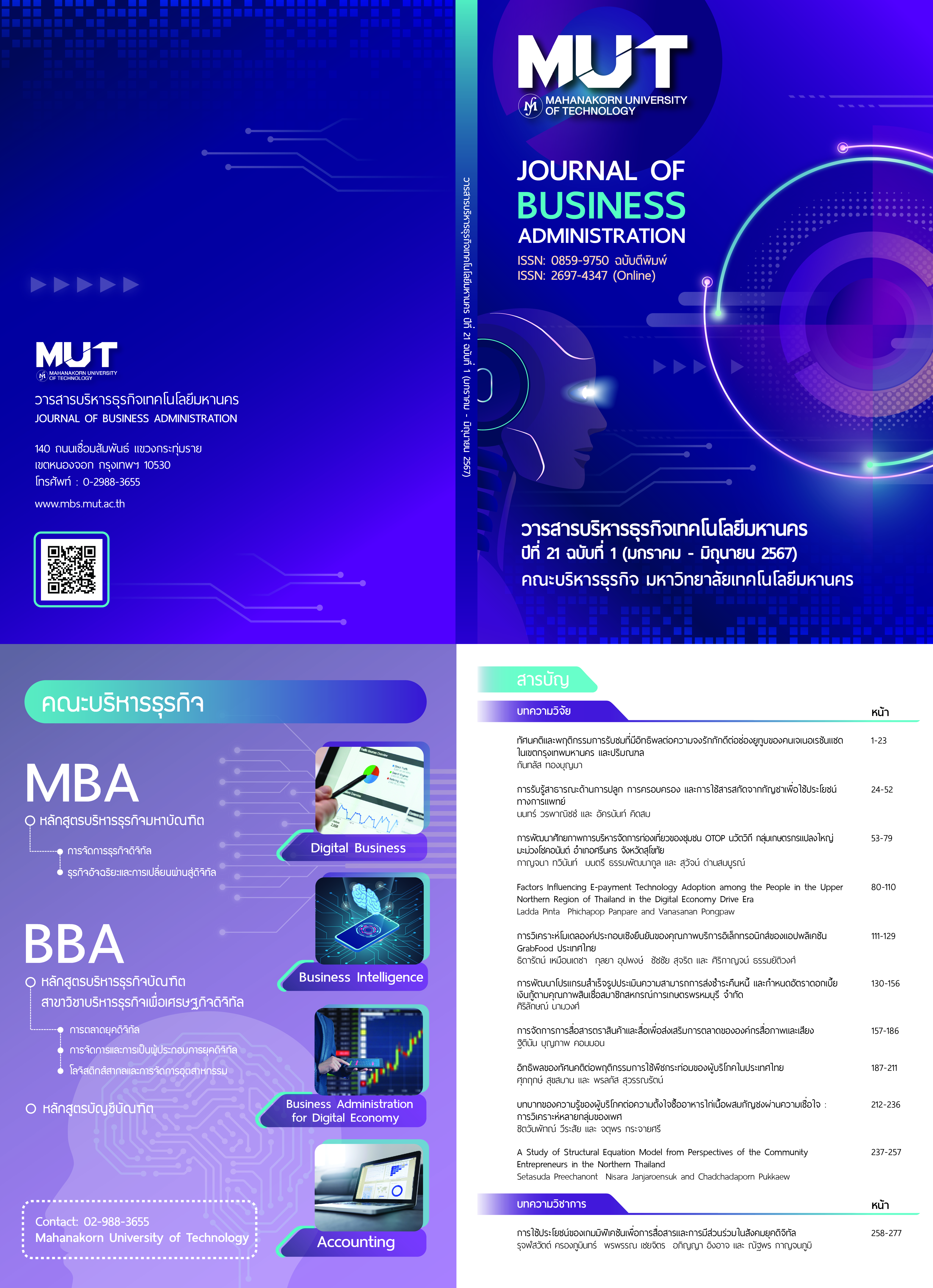The Influence of Attitudes on Usage Behavior of Kratom Consumers in Thailand
Keywords:
Kratom, Attitudes towards the Use, Usage Behavior, Subjective Norms, Ability to Control Behavior, การรับรู้ถึงการควบคุมพฤติกรรมของตนเองAbstract
This research aims to study influence of attitudes on Kratom usage behavior through both direct and indirect effects; the indirect effects were investigated through conformity to subjective norms and the ability to control behavior. The population used in the study was Kratom consumers in the area under the supervision of the Institute for Survey and Monitoring of Narcotic Crops, Office of the Narcotics Control Board (ONCB), in 135 villages/communities located in 8 provinces of the Southern Region namely Nakhon Si Thammarat, Krabi, Phang Nga, Surat Thani, Ranong, Chumphon, Trang, and Phatthalung and 2 provinces in the Central Region, namely Nonthaburi and Pathum Thani. The samples used in the research were 255 people aged 20 years and above who are consuming or had consumed kratom. The tool used for collecting the data was a questionnaire. The data were processed and analyzed by statistical package. The descriptive statistics analyzed basic statistical values such as frequency, percentage, mean, and standard deviation, while the inferential statistics analyzed the indices of conformity for the Structural Equation Model such as Related Chi square, Adjusted Goodness of Fit Index (AGFI), and Root Mean Square Error of Approximation (RMSEA), and analyzed the regression coefficients of variable. The results of the study revealed that attitudes towards the use of Kratom had the direct influence on consumer behavior, subjective norms, and perceived behavior control, but did not have an indirect effect on subjective norms, and perceived behavior control.
References
Ajzen, I. 1991. The theory of planned behavior. Organizational Behavior and Human Decision Process. Vol. 50. 179 - 211.
Ajzen, I. 2002. Perceived behavioral control, self-efficacy, locus of control, and the theory of planned behavior. Journal of Applied Social Psychology. Vol. 32. No. 4. 665 – 683.
Armitage, C. J. and Conner, M. E. 2001. Efficacy of the theory of planned behavior: A meta-analytic review. British Journal of Social Psychology. Vol. 40. 471 - 499.
Atsanangkhornchai, S., Siriwong Na Ayudhya, A., Limsathit, P., Kaewpradub, N., Chittarakarn, S., Wangsintaweekul, J., Kumarnsit, E., Sriviriya-jan, S., Jehha, D., Pumchuen, W. and Saingam, D. 2020. Summary of Kratom Plants. 2nd Ed. Center for Addiction Studies. Epidemiology Unit. Faculty of Medicine. Prince of Songkla University.
Baumgartner, H. and Homburg, C. 1996. Applications of structural equation modeling in marketing and consumer research: A review. International Journal of Research in Marketing. Vol. 13. No. 2. 139 - 161.
Browne, R. C. 1992. Alternative ways of assessing model fit in testing structural equation models. Sociological Methods and Research. Vol. 21. No. 2.
Conner, M. and McMillan, B. 1999. Interaction effects in the theory of planned behavior: Studying cannabis use. British Journal of Social Psychology. Vol. 38. 35 - 54.
Cooke, R., Sniehotta, F. and Schüz, B. 2007. Predicting binge-drinking behavior using an extended TPB: Examining the impact of anticipated regret and descriptive norms. Alcohol and Alcoholism. Vol. 42. No. 2. 84 - 91.
Doll, W. J., Xia, W. and Torkzadeh, G. 1994. A confirmatory factor analysis of the end-user computing satisfaction instrument. MIS Quarterly. Vol. 18. No. 4. 357 - 369.
Eagly, A. H. and Chaiken, S. 1998. Attitude structure and function. In D. T. Gilbert, S. T. Fiske, and G. Lindzey. The handbook of social psychology. 4th Ed. 269 – 322. McGraw-Hill.
Fiksenbaum, L., Marjanovic, Z. and Greenglass, E. 2017. Financial threat and individuals’ willingness to change financial behavior. Review of Behavioral Finance. Vol. 9. No. 2. 128 - 147.
Fishbein, M. and Ajzen, I. 1975. Belief, attitude, intention, and behavior: An introduction to theory and research. London: Addison-Wesley.
Fishbein, M. and Ajzen, I. 2010. Predicting and changing behavior: The reasoned action approach. Psychology Press.
Gefen, D., Straub, D. and Boudreau, M. C. 2000. Structural equation modeling and regression: Guidelines for research practice. Communications of the Association for Information Systems. Vol. 40. No. 1. 7.
Hair, J. F., Jr., Anderson, R. E., Tatham, R. L. and Black, W. C. 2006. Multivariate data analysis. 6th Ed. Upper Saddle River, NJ: Prentice Hall.
Hooper, D., Coughlan, J. and Mullen, M. R. 2008. Structural equation modeling: Guidelines for determining model fit. Electronic Journal of Business Research Methods. Vol. 6. No. 1. 53 - 60.
Jung, T., Dieck, M. C. T., Lee, H. and Chung, N. 2020. Relationships among beliefs, attitudes, time resources, subjective norms, and intentions to use wearable augmented reality in art galleries. Sustainability. Vol. 12. No. 20. 8628.
Karimy, M., Zareban, I., Araban, M. and Montazeri, A. 2015. An extended theory of planned behavior (TPB) used to predict smoking behavior among a sample of Iranian medical students. International Journal of High-Risk Behaviors & Addiction. Vol. 4. No. 3.
Kline, R. B. 2011. Principles and Practice of Structural Equation Modeling. 3rd Ed. New York: Guilford Press.
Kyndt, E. and Onghena, P. 2014. The integration of work and learning: Tackling the complexity by means of structural equation modeling. In Harteis, C., Rausch, A. and Seifried, J. 2014. Discourses on professional learning: On the boundary between learning and working. Springer: Berlin/Heidelberg. Germany.
Malhotra, N. K. 2005. Attitude and affect: New frontiers of research in the 21st century. Journal of Business Research. Vol. 58. No. 4. 477 - 482.
Mueller, R. O. 1996. Basic Principles of Structural Equation Modeling: An Introduction to LISREL and EQS. New York: Springer-Verlag.
Nunnally, J. C. and Bernstein, I. H. 1994. Psychometric Theory. 3rd Ed. New York: McGraw-Hill.
Park, H. S. 2000. Relationships among attitudes and subjective norms: Testing the theory of reasoned action across cultures. Communication Studies. Vol. 51. No. 2. 162 – 175.
Pickens, J. 2005. Organizational Behavior in Health Care. Sudbury. MA: Jones and Bartlett Publishers.
Rungrueng, W. 2020. Toxicology of kratom plants. Journal of Hospital Pharmacy. Vol. 30. 118 – 124.
Saion, W. 2021. Kratom Plant. Secretariat of the House of Representatives. Bureau of Academic Services, Radio and Television Broadcasting Station of Parliament.
Retrieved May 25, 2024 from https://dl.parliament.go.th/backoffice/ viewer2300/
web/viewer.php
Suwannarat, P. 2023a. Understanding the difference of values-based motivation of managerial workers in spa businesses in Thailand. International Journal of Emerging Markets. Vol. 18. No. 2. 483 - 504.
Suwannarat, P. 2023b. The Moderating role of trust in influencing the effectiveness of export incentives of exporters in the ASEAN. Journal of Asia Business Studies. Vol. 17. No. 2. 279 - 307.
Tseng, T.-S., Lin, H.-Y., Chia-Hsien Cheng, Y. and Chen, T.-H. 2017. Predictors of smoking cessation behavior and intentions among smoking cessation clinic patients in Taiwan. BMC Public Health. Vol. 17. 1171.
Veltri, C. and Grundmann, O. 2019. Current perspectives on the impact of Kratom use. Substance Abuse and Rehabilitation. Vol. 10. 23 - 31.
Walley, K., Custance, P., Parsons, S. and Lindgreen, A. 2009. Longitudinal attitude surveys in consumer research: A case study from the agrifood sector. Qualitative Market Research: An International Journal. Vol. 12. No. 3. 260 – 278.
Widjaja, I., Arifin, Z. Z. and Setini, M. 2020. The effects of financial literacy and subjective norms on saving behavior. Management Science Letters. Vol. 10. 3635 – 3642.
Widyastuti, U., Suhud, U. and Sumiati, A. 2016. The impact of financial literacy on student teachers’ saving intention and saving behaviour. Mediterranean Journal of Social Sciences. Vol. 7. No. 6. 41 – 48.
Xia, Y. and Yang, Y. 2019. RMSEA, CFI, and TLI in structural equation modeling with ordered categorical data: The story they tell depends on the estimation methods. Behavior Research Methods. Vol. 51. 409 – 428.
Additional Files
Published
Issue
Section
License

This work is licensed under a Creative Commons Attribution-NonCommercial-NoDerivatives 4.0 International License.
ข้อความ ข้อคิดเห็น ข้อมูล เนื้อหา รูปภาพ แผนภูมิ แผนผัง เป็นต้น ที่ปรากฏและแสดงในบทความต่างๆ ในวารสารบริหารธุรกิจเทคโนโลยีมหานคร ถือเป็นความรับผิดชอบโดยตรงของผู้เขียนบทความนั้นๆ มิใช่เป็นความรับผิดชอบใดๆ ของวารสารบริหารธุรกิจเทคโนโลยีมหานคร และมหาวิทยาลัยเทคโนโลยีมหานคร
บทความที่ตีพิมพ์ในวารสารบริหารธุรกิจเทคโนโลยีมหานคร ถือเป็นลิขสิทธิ์เฉพาะของคณะบริหารธุรกิจ มหาวิทยาลัยเทคโนโลยีมหานคร หากบุคคลหรือหน่วยงานใดต้องการนำทั้งหมดหรือส่วนใดส่วนหนึ่งไปเผยแพร่ต่อหรือเพื่อกระทำการใดๆ จะต้องได้รับการอนุญาตเป็นลายลักษณ์อักษรจากคณะบริหารธุรกิจ มหาวิทยาลัยเทคโนโลยีมหานครก่อนเท่านั้น


